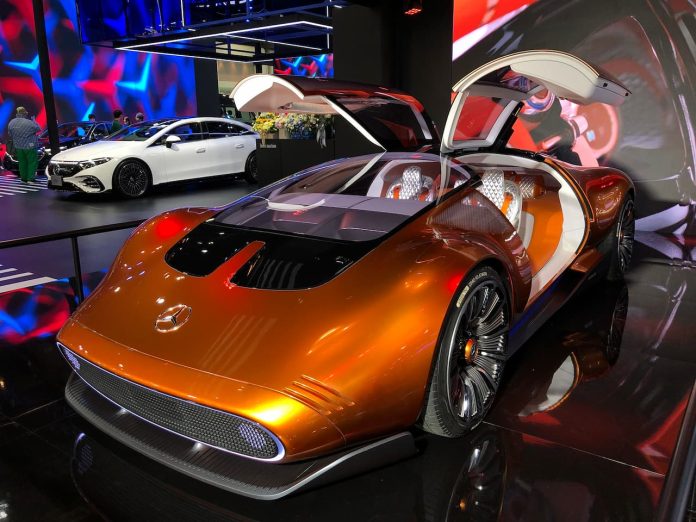We recently got a chance to see the Mercedes Vision One-Eleven concept up close. Unveiled globally last year, this EV is not a production-oriented model, but it has plenty of technology and interesting features that we expect to see in future all-electric Mercedes road-going cars.
Here are 5 things we learned during our demo of the Mercedes Vision One-Eleven concept, and what it means for future Mercedes models:
Design inspired by the C 111

The all-electric One-Eleven concept is inspired by the design language of Mercedes-Benz’s C 111 experimental cars from the 1960s and ’70s. The Vision One-Eleven and the C 111 share the use of gullwing doors and a unique color scheme (orange for the C 111 and copper-orange alubeam for the Vision One-Eleven). The vintage model was known for its aerodynamic shape, and the Vision One-Eleven continues this trend with its sleek One-Bow design and aerodynamic features like flush-fit gullwing doors and large-diameter wheels.
That said, the Vision One-Eleven is not a replica of the classic. We were able to spot unique elements such as a flexible external display with a 3D pixelated look on the front panel, which can convey messages and integrates digitized round lights. It also has a unique U-shaped, strongly profiled front apron with black air intakes on the bonnet.
Axial-Flux Motor Technology


The One-Eleven is powered by an axial-flux electric motor, which comes from YASA, a British engineering firm that was acquired by Mercedes in 2021. Axial flux is a big departure from the usual radial-flux motors seen in current electric vehicles. It offers considerable advantages in weight, size, and efficiency.
For an idea, Mercedes says that its axial-flux motors offer motorsport-level performance from a small package. The motor is powered by a liquid-cooled cylindrical-cell battery with F1-inspired cell chemistry. We’ll see this technology in a production Mercedes EV when the next-gen Mercedes-AMG models debut next year, riding on the AMG.EA platform.
Minimalist interior & futuristic vibe
The interior of the all-electric Mercedes-Benz Vision One-Eleven blends a minimalist sports car feel with a luxurious lounge concept, featuring silver bucket seats with integrated seat cushions, a compact center console, and a rectangular steering wheel. On observing the interior closely, the seats, displays, and the steering wheel looked like precursors to Mercedes’s future performance electric vehicles.


The cabin utilizes advanced materials such as 100% recycled polyester for the dashboard and coffee bean husk-tanned leather for the armrests and rear parcel shelf. The design also includes a pixel display, the Magic Leap 2 augmented reality headset, and elements from the MBUX Hyperscreen. The sustainability initiatives and minimalist design can also be expected to translate to production performance Mercedes models which are all-electric.
Innovative Aero & Lighting
One glance at the Vision One-Eleven EV and it’s clear that it features advanced aerodynamics that seamlessly integrate with its design aesthetic. We quite like its large-diameter wheels inserted into flared wheel arches, enhancing its sporty and aerodynamic profile.
Additionally, the Vision One-Eleven uses innovative lighting elements, such as blue backlit piercings along the aerodynamic profile and circular lighting elements inside the wheels, which not only improve visibility but also add to the car’s futuristic and high-tech appearance.
If you ask us, there is really not much in this regard that can be expected in showroom models. The lighting system of the concept, if carried-over to the production vehicle, could face homologation issues, and would have to be modified extensively for safety and compliance. Mercedes and AMG would also want to keep the design language familiar, and the radically-designed Vision One-Eleven is an outlier in this aspect.
Combination of Physical & Digital features
We found the user interaction with the Vision One-Eleven quite special, as it blends physical and digital experiences. The advanced augmented reality interface, developed with Magic Leap, overlays contextual information directly into the driver’s field of view.


This AR system is designed to enhance situational awareness by projecting navigation cues, hazard alerts, and other critical data into the real-world environment. It merges the car’s interior with the outside world, and if it translates into production, would offer drivers an intuitive and immersive driving experience. We think this could be the evolution of the MBUX Hyperscreen which we experienced in the EQE and EQS series.

An automobile engineer by training, I’ve analyzed the global car market since 2005, with a keen focus on EVs since 2008. My journey in online automotive publishing spans 16 years, during which I have reviewed cutting-edge automotive technologies and interviewed leading CEOs and vehicle developers from around the world.









